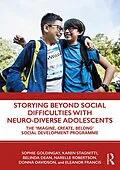Traditional approaches to social skill development may often be ineffective for those in most need of them - those who are neuro-diverse (for example, on the Autism Spectrum, with dyspraxia, or with Attention Deficit Hyperactivity Disorder), those who have experienced trauma, those with an intellectual disability, and those who present with Complex Communication Needs. This may be due to difficulties with language, attention, and memory.
Storying Beyond Social Difficulties with Neuro-Diverse Adolescents is a manual that outlines an eight-session programme, called "Imagine, Create, Belong", that involves a range of activities designed to develop theory of mind, flexible thinking, empathy, and narrative ability. The sessions can be run across 8 or 16 weeks and contain sections suitable for those in mainstream schools, with adaptations to support adolescents with additional needs (including moderate intellectual disability and Complex Communication Needs). The manual does this via a range of age-appropriate play-based activities within a group setting focused on making a movie. It includes non-verbal and verbal approaches to social development and is an implicit approach to social skills.
The programme is suitable for young people aged 11 years to 15 years with social difficulties. It includes content that may suit adolescents from both individualist and collectivist cultures. The manual provides step-by-step guidance for practitioners to run the "Imagine, Create, Belong" social skills programme with participants with a range of intellectual abilities who have been identified by parents, teachers, or other professionals as having social difficulties.
Autorentext
Sophie Goldingay (BA, PGDipSocWk, GCHE, PhD) is a senior lecturer and Associate Head of School, Teaching and Learning, in the School of Health and Social Development, Deakin University. Her research interests include developing an evidence base for inclusive programs and teaching approaches in secondary school and university settings, which prepare diverse students for 21st Century work and life contexts.
Karen Stagnitti is Emeritus Professor in the School of Health and Social Development, Deakin University, Geelong, Australia. She has been researching and publishing in the area of play for over 25 years. Each year she is invited nationally and internationally to present her work in play assessment and Learn to Play Therapy
Belinda Dean (BA, MA, RND1) is a lecturer in Nursing at Deakin University and holds a master's degree in Child Play Therapy. Belinda has 19 years' experience in Child & Adolescent Health, Mental Health, Community & Family Health. Belinda is a past facilitator of the Imagine, Create, Belong program and author of related published papers.
Narelle Robertson (BA) is a researcher at the Centre for Project Evaluation at Melbourne University. Narelle has over 10 years' experience in psychology, occupational therapy and public health research. Narelle is a past facilitator of the Imagine, Create, Belong program and author of related publications.
Donna Davidson (BA, MA) is an Occupational Therapist and Play Therapist. Donna has worked with children in a variety of settings, including school and community settings, for over 18 years. Donna completed her thesis on the Parent Learn to Play Therapy program. Donna has a passion for working with children and young people with additional needs.
Eleanor Francis (BA, MA) is a Speech Pathologist who has worked with children and adults in a variety of settings. Eleanor currently works in the area of Augmentative and Alternative Communication (AAC), supporting individuals with little or no speech to thrive in social and vocational environments. Eleanor is interested in the strong links between play and language development
Inhalt
List of Figures and Tables
Foreword
Acknowledgements
Chapter 1. Adolescence and Social Interaction
Chapter 2. How to Use this Manual
Chapter 3. Session 1: Setting the Scene
Chapter 4. Session 2 Participants' Life Story and the Life Story of the Character
Chapter 5. Session 3: Narrative and Identity: How Does Your Character Act and Feel?
Chapter 6. Session 4: Context, Plot Structure, Props and Scenes
Chapter 7. Session 5: Beginning to Identify Problems to Solve in the Story
Chapter 8. Session 6: How Will the Characters Solve the Identified Problems and What Are the Props for The Movie?
Chapter 9. Session 7: Bringing it All Together
Chapter 10. Session 8: The Grand Finale
Chapter 11. Epilogue
Appendices
